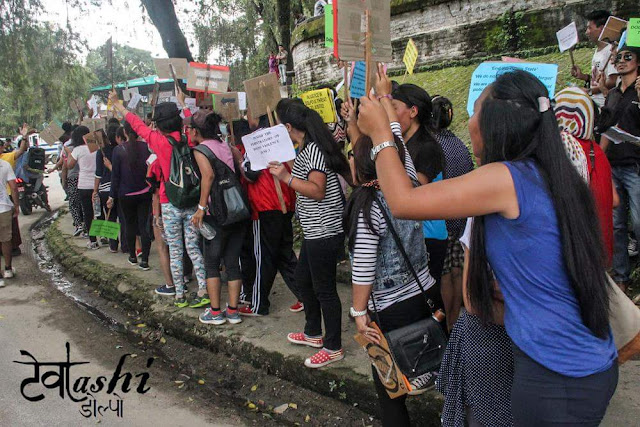'Atyadhunik' Police Check Post in Dho-Dolpo and some concerns... #state #security #indigenous #geopolitics
It was June 14, 2014 when two Dolpo locals were killed by
the state security officials in Dho-Tarap (currently falls in Dolpo Buddha
Rural Municipality). In addition, nearly ten locals were caught and later put
in prison in Suligaadh, Dunai (one of the prison in the Army Camp of Dolpa)
where they were also tortured and threatened not to speak anything against the state.
Consequently, many delegations and protests nearly for four months led by
locals also in Kathmandu somewhat failed to convince the state to provide
justice to deceased and their family. Kantipur national media and its two media
person even for the first time went to Dho (at-least 500 kms away from Kathmandu)
itself and later analysed the violence and injustices happened to locals. One
of the noted scholar including Deepak Thapa and CK Lal later even wrote about
the particular incident. Here is the link of the article written by former: http://kathmandupost.ekantipur.com/printedition/news/2014-06-18/death-in-dolpo.html.
At a personal level, this violence also forced me to critically
analyze the relationship of the Indigenous locals with the state and to certain
extent, I know that I have written few about that cycle of violence. Moreover,
it was the first time in a living memory that the state used its brutal force
to silence Dolpo. Its impact upon the locals in Dho and other scattered
communities of Dolpo are still required at-least at a research level
recognizing those silenced voices.
Now, let us go back to a present scenario in Dho-Dolpo,
where obviously at a political front, something has changed. First, the
Annapurna post reported the news http://annapurnapost.com/news/107892
about the post. As per the news, it is somewhat clear that Minister Naresh
Bhandari, Karnali Province Minister for Internal Affairs and Law Ministry
wanted to build this ‘atyadhunik’ (advanced) Police station in Dho. When he
reached in Dho for the field survey, he even assured that he would be willing
to spend NRs. 100 million for the project. He further emphasized the need for
Dho to develop in a tourism sector and as an economic center for Nepal, India
and China. Though he also said that from now onwards the police will stay in
Dho for twelve months, he left many questions unanswered. What will be the
nature of the building of that police station? Did anyone of he and his deputies talk
with mainly the local government including Chairperson and Vice-chairperson of
Dolpo Buddha Rural Municipality and the locals about the project? In what
level? Can the province government decide for the local government at a
municipal level? How will this development further impact the relative autonomy
of whole Dolpo?
Besides these questions, one also need to be mindful about the
historical and contemporary state of such police stations and their police
officials. To make the historical narration brief, locals were always
marginalized and their concerns were rarely addressed. For instance, it will be
impossible to find even one single Dolpo in that huge institutions spread both
in Dolpa (the biggest district) and Kathmandu or any other region. If the
institution including that of the state has been somewhat lenient towards the
locals, why does the government report made out of Dho incident still kept private?
In the present scenario, there are rarely any instances that can alter the
local perspectives towards the police. What is happening in the Nirmala Rape
Case and what happened in many other incidents starting from Tharuhat movement
to Madhesh movement especially how locals were treated, the police station is
not the one state’s institution one wants close to your locality.
On the other hand, local government in Dolpo could have
acted more responsibly. It would have been much better if Dolpo locals and
their local governments in three rural municipalities would have further consulted
with their locals including many unemployed youths and try to come up with a
solution to stop the increasing looting and robberies in the area. Can’t the
local government suggest youths to make their own security groups including youths
both at a village and a community level? With a proper monetary incentives to
such local youths from the local government budget, not only an employment opportunity
could have been created, it would have also helped those ‘fracturing’ scattered
communities to reimagine and re-enact upon their collective solidarity. Aren't we missing something?
Anyways due to time constraints and my next Grad class, I am yet to discuss about
the impact of ongoing geo-politics involving India, China, Nepal and the USA and where this security situation of Dolpa and Dolpo falls in.
Besides sharing few youtube and media links, I will share here that recently two former Indian Ambassadors also visited Dolpa. Why were they there? To see that visit limiting to a mere temple visit in Lower Dolpa would be a too simplistic and naive argument to make. Anyways, that also begs a proper reading also from a historical context. And the recent BIMSTEC summit in
Kathmandu also showed the urgency about somewhat improving the state of
security in Asia led by India commented by Sudheer Sharma, former Editor of Kantipur, one of the major national dailies.
Below are the links that could be more helpful.
https://www.youtube.com/watch?v=JJAanaiMN84: Arundhati Roy's take on the military relationship between India and the USA.
Still at the end of the day, I will be pessimistic about the continuous intervention of the state in Dolpo especially in terms of Dolpo benefiting from that relationship. Still I will be more than happy, if I am proven wrong...





Comments
Post a Comment